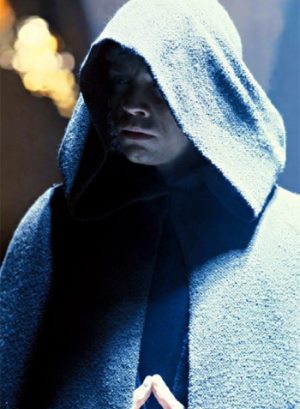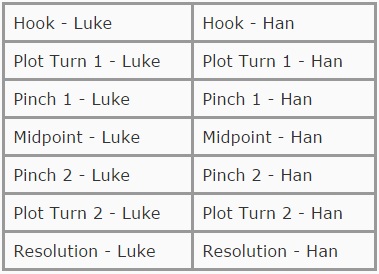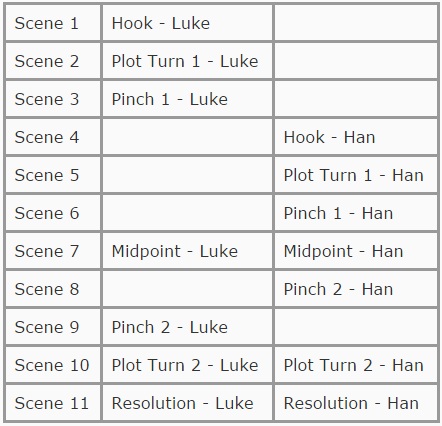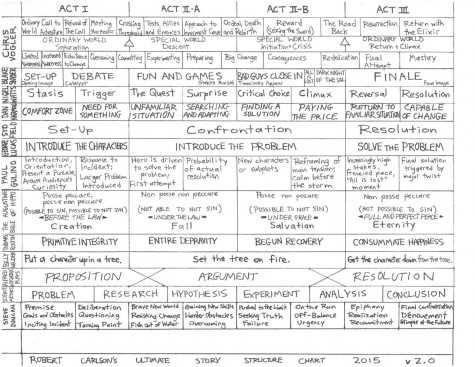 This is the third part of a three-part series on story structure.
This is the third part of a three-part series on story structure.
The first part began a discussion on the Three-Act Structure. The second part continued that discussion. This third part explores Seven-Point Story Structure and plot weaving.
So where were we?
Oh yes, we had just finished breaking down Star Wars into the key components of the Three-Act Structure. And I’m here to say we’re here to do it again, but with Dan Well’s Seven-Point Story Structure. You’ll see similarities and differences in the way things break down, and most importantly of all, you’ll see the way in which the Seven-Point Structure helps in weaving together multiple plots.
As George Lucas once said in regards to his prequels, “You see the echo of where it all is gonna go. It’s like poetry, sort of. They rhyme.”
I just hope the rhyme is sweet and haunting not crude and off-putting like a wet—ahem—moist flatulence.
Seven-Point Story Structure
Like the Three-Act-Structure, the Seven Point Structure seems simple on the surface, but its application can become infinitely complex. You will see why when I discuss multiple plots. The seven points that comprise this structure are as follows:
1 – The Hook
2 – Plot turn 1
3 – Pinch 1
4 – Midpoint
5 – Pinch 2
6 – Plot turn 2
7 – Resolution
OK, that’s a nice little list, but what the heck does it mean? Each point is a key moment in the progression of a plot. You can think of it as the skeleton on which you build the story’s muscle and connective tissue.
To use this structure and develop your plot, you don’t want to fill in the slots linearly from 1-7. You start at the resolution, at where you want your plot to end up and work your way through in the order I’ll show. Truthfully, the order doesn’t matter. You can fill things in however you want. This is just the way I learned things, and I think it makes sense to work this way.
So, let’s go back to a galaxy far, far away and Luke’s plot.
7 – Resolution – At the end of the story, Luke is a hero of the rebellion, having flown his X-Wing in an epic battle to destroy the Death Star, and has taken steps to becoming a Jedi like his father.
Now that we have the end, we can go back to the beginning. At the beginning, the Hook, you’ll have your character in the opposite state as the resolution.
1- The Hook – Luke is a lowly farm boy who dreams of going to the academy to be a pilot like his father.
To get from one point to the other, the character must change. At this point, you might be asking yourselves “What about characters who don’t change?”
Unchanging characters must have their beliefs challenged during the course of the story. The way I look at it is in the resolution the character remains steadfast in their beliefs, and their beliefs have been proven to hold true by the events of the story.
So what would be the opposite of that be? The character is unsteady in their beliefs or doubts them in someway. They may be tempted from the true path.
Next up, we have the midpoint. Like in the Three-Act Structure, this is a very important point in the progression of the plot. In the Seven-Point Structure it’s defined as the point where the character moves from reaction to action. It’s the exact point between the two states of the Hook and the Resolution and helps launch your character towards the end state.
4 – Midpoint – Until now Luke has been reacting to what the Empire has thrown at him, but when they’re tractor beamed into the Death Star, Luke learns the Princess is on board. It’s here where he begins to act. Instead of just worrying about his own escape, he convinces Han to help him infiltrate the prison wing and rescue the Princess.
Up next, well take on Plot Turn 1. Just as the midpoint launches your character towards the end, Plot Turn 1 launches your character towards the midpoint. This is where the character learns things and their world changes. Conflicts get introduced.
To me, this overlaps with the Three-Act Structure’s Inciting incident.
2 – Plot Turn 1 – Luke encounters the droids, specifically R2-D2, and finds the secret message from the Princess.
Now that we have Plot Turn 1, we’ll take on Plot Turn 2. Similar to Plot Turn 1, Plot Turn 2 is what launches your character from the midpoint to the resolution. This is where your character realizes that they have everything they need to achieve their goal for this plot thread. The power is within them to win. They just have to go and do it. Dan Wells describes Plot Turn 2 as “Snatching victory from the jaws of defeat.”
6 – Plot Turn 2 – Luke hears Ben tell him to let go and use the force. He turns off his targeting computer, and before Vader can blow him out of the black, Han Shows up. With the way clear, Luke lets the Force guide him, and of course, he makes the shot. Luke had true friends, the plans to the Death Star, and the Force, and that’s all he needed to win.
Now that we have the two turns in the plot, we’ll head into the pinches. A pinch, as implied by the name, applies pressure on your character. It forces them into decision, and is often where you character gets a taste of what the villain is capable of.
3 – Pinch 1 – Stormtroopers kill Uncle Owen and Aunt Beru. This forces Luke to make a decision, stay on Tatooine or go with Ben. There’s nothing left for him on Tatooine, so he chooses to leave.
In Pinch 2 even more pressure is applied, turning the situation into one that seems hopeless. Dan Wells describes this as the jaws of defeat from which your character must snatch victory.
5 – Pinch 2 – With only a few Rebel fighters left, Luke makes his final trench run. All his support disappears under the flash of laser fire, including R2-D2 and his childhood friend, Biggs Darklighter. He’s alone as Darth Vader locks on to him with his targeting computer.
It’s all over until a certain Corellian smuggler shows up and shoots first.
That’s the Seven-Point plot structure, but there’s one more element to it. Dan Wells calls it the Ice Monster Prologue, after the prologue from the first Game of Thrones book. Though, it doesn’t have to be a prologue in a traditional sense. The rhyme and reasons for using a traditional prologue is a can of worms I’ll leave closed for now.
Like all prologues, this is optional and it’s up to the author to determine if it’s necessary for their story.
For now, think James Bond opening sequence. That’s more of what I’m talking about with this.
When the hook is slow, one might want to start with something more action oriented to whet the reader’s appetite, and hint at what’s to come. It’s a promise to the reader that if they’re patient and let you set things up, there will be a good payoff when things get going. The momentum gained through this helps carry the reader through slower setups.
0 – Ice Monster Prologue – This is the famous opening scene of Star Wars with the small rebel ship running from the massive Star Destroyer. We’re introduced to the Rebel Alliance, Princess Leia, the Empire, Darth Vader, and their struggle against one another.
In Star Wars, the story would still work without the Ice Monster Prologue, but it definitely wouldn’t feel as exciting at the beginning. It’d probably feel more like a mystery as Luke discovers the secret message and goes about trying to figure out what it means. In addition, the audience would have to discover what the Empire is all about, who Princess Leia is, and what the conflict is between them. But with the Ice Monster Prologue in place, that mystery is minimized, and we can focus more on Luke and who he is.
Why?
When you look at the two big-picture structures I’ve talked about, you may be wondering why I use both of these. They’re similar. Why not just use one? If you read my previous article on why we need structure, you’ll understand this gives me two different views on a story, and it gives me a different way to think about things when I run into trouble.
But for me, the biggest reason I use these two structures lies in the different ways I use them. With the Three-Act Structure, I plan out the overall story, put set pieces in place and figure out how things flow. With the Seven-Point Structure, I plan out each individual plot thread, which brings us to the next section.
Plot Weaving
When I started studying writing, one of the things I had trouble finding information on was how to deal with multiple plot threads. There are plenty of books and articles that talk about how to develop your main story, but I could never figure out how things would apply to multiple main plots and subplots.
But then I encountered the Seven-Point plot structure and had a duh moment. I wasn’t thinking about things in the right way.
You see, each plot, sub or main, is a story in itself. Conceptually, they’re the same, each with its own first, second, and third acts or hook, plot turn 1, pinch 1, etc. The difference is with subplots things may be abbreviated and skipped. How much you abbreviate depends on how fast you need things to move along, how little “screen time” you need to make things work, and the importance of the subplot relative to the main plot(s).
In my eyes, the purpose of a subplot is to support the main plot. If it doesn’t do that, it’s a candidate to be edited out or minimized to the barest of bones.
As I mentioned earlier, Star War’s main plot is Luke’s plot, and I broke it down above. To demonstrate plot weaving, I’ll quickly break down Han Solo’s subplot using the Seven-Point Structure.
1 – Hook – Han is a money-grubbing scoundrel, who thinks only of himself.
2 – Plot Turn 1 – Han takes Luke and Ben on as passengers, on the promise of more money.
3 – Pinch 1 – The Empire discovers Han is transporting the droids and the Millennium Falcon escapes under a hail of laser fire.
4 – Midpoint – Han decides to help Luke with his plan to rescue the Princess, with the promise of even more money.
5 – Pinch 2 – Han takes his money and leaves to pay Jabba and save his own butt.
6 – Plot Turn 2 – Han returns to save Luke from Vader.
7 – Resolution – Han chooses friends over money, his own safety, and is a hero of the rebellion.
You’ll notice that Han’s plot and Luke’s plot have overlaps and near overlaps, specifically at the midpoint and plot turn 2. These are the points where the plots connect most closely with each other and where the subplot supports the main plot most obviously.
Putting it All Together
So, we have Han and Luke’s plots. There are obviously other subplots in Star Wars, but for the sake of brevity in a very long article, I leave those for you to discover. Of note, main characters usually have two key plots associated with them, an external plot and an internal plot, sometimes called the emotional plot. Luke’s external plot involves saving the princess and fighting the empire, and his internal plot involves becoming a Jedi like his father.
What I’ve focused on in this article is Luke’s external plot, and I’ve only touched on his internal one. Though both are closely linked like Luke and Han’s.
Conceptually, weaving plots together is fairly simple. For myself, I start by creating a table in excel and lining up the plot points up next to one another like the following, except with the actual text describing the plot points instead of just the character’s names.

Now as I plan/write my scenes, I can decide which of my plots to advance in each scene. Each will advance at its own pace, so if I were to create a chronological table of scenes, and show what plot they advance, it might end up looking like this.

For Star Wars with its many plots, the number of scenes will expand, so the overlap of plots within scenes will increase, and the table will become more complex. In addition, you can zoom out and apply this structure to multi-book, episode, or movie stories. A series’ overarching plot is just another plot in the table. It just advances slower.
If you think of your main overarching plot as a rainbow, the main plot of each book is a smaller rainbow beneath it, say three for a trilogy. And under each of those three rainbows are a bunch of smaller ones. Each is an unfolding plot that may stretch across multiple volumes.
To me this can get confusing. That’s why I use a table. It helps me keep track of where I am in my plots, so I don’t leave things dangling, unless I want to.
Also, I think this table illustrates one important thing in regards to scenes. You can move multiple plots along easily if you design your scenes well. But that’s something I’ll cover that in my next article, which will cover micro-level structure.
Hopefully, this very-very long article helps some in visualizing their stories and plots, and helps them understand how to weave it all together into a fluffy quilt of awesome. If you want to learn more on Structure, I’d recommend the following resources.
1 – The book Elements of Fiction: Plot
2 – The book Save the Cat on screenwriting
3 – On YouTube, Dan Wells’ Seven Point Plot Structure, a five-part video series
In his videos, Dan goes more in-depth with the Seven-Point Structure and he breaks down stories like The Matrix and Harry Potter into their many plots. You’ll probably also notice slight differences in how I think about things and how he does, so feel free to slam me if you think I’ve gotten things wrong. It wouldn’t be the first time.
Oh, as a bonus supplement to my previous article, Do Writers Really Need to Know Theory?, I give you this awesome chart I found on reddit, created by a gentleman named Robert Carlson. Cheers to you, Sir. It shows how various writing theories line up side-by-side and show how they’re all just different looks at the same thing. IMHO It’s a work of art.
Click the image to enlarge it:
(Source: https://www.reddit.com/r/writing/comments/2vmri3/made_a_chart_that_combines_every_story_structure/)
Until next time, keep thinking, keep writing, keep on getting on, and may each word you write be better than the last.
And may the Force be with you… always.
For Further Discussion
How do you think about structure and plotting weaving on the macro-level? Can you spot these things at work in The Force Awakens?
Have you tried Seven-Point Story Structure? How did it work out?
How do you keep track of your plots? Do you have a method that works well for you?



Excellent article on plot!! I learned the hard way what happens when you write by the seat of your pants then come across plot holes you otherwise wouldn’t have if you’d only spent a few easy minutes plotting. The best book I ever read on this is “PUNCHING BABIES: a how-to guide” which completely transformed my writing. Thanks to PUNCHING BABIES I have almost twenty novels published where before i struggled for almost as much time fixing plot holes and re-writing as i did writing! LoL
A very helpful article, thanks. I tend to write from the seat of my pants, but have learned –the hard way– that following a loose outline and plot structure can save my editing budget down the line. I recently featured a post on my blog with 5 key plotting techniques, which you might find interesting. http://catehogan.com/how-to-write-a-novel-plot-structures/
I like that the 7 point system helps address subplot, but it feels a little unwieldy to me…maybe because I’m not crazy about pre-structuring my writing in the first place (working on it!). Loving the Star Wars breakdowns!
Wow, the whole series shines a lot of light. I really like the way you’ve shown us two discrete ways to structure plots, because they reinforce each other but also leave a lot of latitude for creative thinking.
Stories can be examined from lots of different angles, and the analogy of looking at a car from all different angles really fits when you’re diagnosing and fixing the problems.
Thanks so much!
Responses like this is one of the reasons I write the articles. The others are fortune, glory, and power enough to dominate the word, but I digress. :p
I’ve encountered some great teachers in my life, and this is me, in a small way, trying to pay it forward.
Cheers
I really like that you use Star Wars for your analogy as it makes this much easier for me to follow and much more interesting than straight theory. Your broken-down graphs are extremely handy, too! Planning is everything, and you’ve made it look so easy.
Any reason to geek-out about Star Wars 😀
John…wow….I felt as if I wasted money going to school to learn this. :/ Anyways, I haven’t yet read any of those. My boyfriend is actually a screenwriter, so he does have that book “Save the Cat”, which he’s been telling me to look at. Guess I will now. And I’ll definitely try out your chart…..it could possibly help me categorize my ideas and allow me to see the potential overall picture. I’ve enjoyed your posts. And good luck to all, and wish me luck! 🙂
Hey Tessa
I’m really happy you found this helpful. When you’re starting out, you never know what works for you until you try it.
Hopefully this will be a keeper 😀
But don’t worry if this doesn’t 100% click for you. There is no right way to do things. There’s just the way that works for you. And like I said, you have to try different things to figure that out.
And remember, everyone stumbles in their writing, but always remember you can always recover and make it better in the next draft.
Good luck.
John W.
Wow, you’ve got this down. I think it’s great, and will follow your directions as much as I can, the problem with me is that I can’t plot things that far ahead. I like the idea of figuring out the bare bones to hang the rest of the story on – clearly you need to know where you’re going and how you want to get there, but when I start writing my characters tendto go off on their own and do things I hadn’t planned on. Once again, you need to stick to your plot line, and this is a good example of how to do just that.
There’s nothing wrong with veering off in a different direction than planned. It happens to me all the time.
Nothing is ever written in stone.
I think one of the great things of planning things this way is it enables you to make informed decisions when making changes. You can take your intended change and then glance over your plot threads and get a good idea of how the change will ripple through your story.
You’ll see what changes you’ll have to make to your various plots, if any. Sometimes you’ll see it makes the story way better. Other times, you’ll see that it takes the story in a direction you don’t want to go.
And if you decide to make the change, you can use your outline to pinpoint the spots where you’ll have to edit what you’ve written so far.
Oh, and one thing, these methods are just tools. Don’t treat them as gospel. Take them and use them however you want. You can adapt and tweak them to how you like to work.
But it’s just like learning how to do anything else. First learn and understand the standard way to do it, then take that understanding and do it however way you like.
If it works for you then it works for you.
Good luck with your writing.
Hi John (penpilot),
Thank you so much for this! This was so unbelievably helpful right now!
The charts are particularly helpful, as I tend to be very visual. My story board is a work of art…
PS, I love seeing UBC and The Canucks listed with your bio 🙂
I’m glad you found this helpful. I always think if this gives just one person a little help then it was worth writing.
See you around the board. 😀